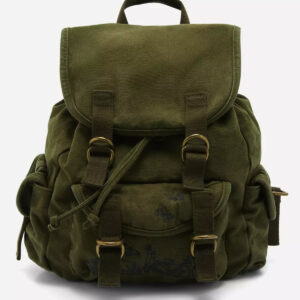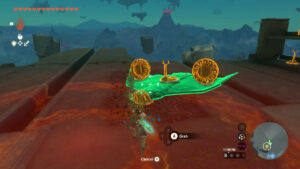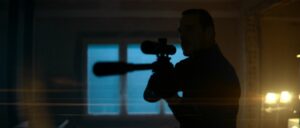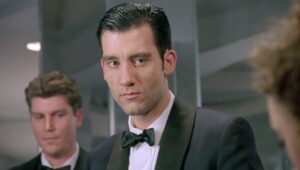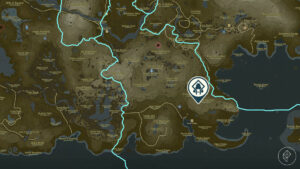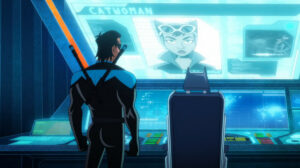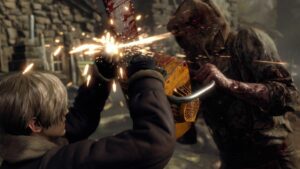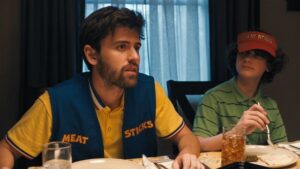After the expansiveness of the first season of Vinland Saga, crossing continents as dramatizations of historic figures cross paths, it’s tempting to say that the anime’s second season is of a much smaller scale. But Vinland Saga season 2 feels epic in a different sense, as director Shūhei Yabuta and writer Hiroshi Seko deliver some of the series’ most breathtaking drama within the (rather expansive) boundaries of a farm.
Since the first season, Thorfinn has been enslaved by a wealthy man who has styled himself as a benevolent slave owner, letting his indentured farmhands work off what he paid for them and earn their freedom back. The farm is a space that shelters Thorfinn from his past as a berserker. But his friendship with Einar, another slave working the same bit of land, reminds Thorfinn of what he destroyed as a warrior, prompting him to consider how he might stop it from happening again.
This arc of Vinland Saga is lovingly referred to with the tongue-in-cheek moniker “Farmland Saga” by some fans, in part because of its narrative decompression, its smaller scope, and its pull away from warfare in favor of seeing Thorfinn gradually change. It emphasizes long passages of time in his clearing of forest land, and the meditative nature of it — growing something instead of pillaging.
The first season was compelling for how far down it dragged Thorfinn, hollowed by his experiences and commitment to being a mercenary for his father’s killers, tragically destroying himself as he relentlessly pursued revenge on his enemy and paternal figure Askeladd. There’s fun in seeing the show’s fondness for historical drama, its little background details, and the license it takes with character motivations as it adapts Makoto Yukimura’s manga series. But a lot of the most compelling moments come from its continuing engagement with the leading tenets of feudalism and Viking culture (“might makes right,” as a participant in a losing battle puts it). Season 2 is compelling for how it rebuilds him anew, and how long it’s willing to take to do so.
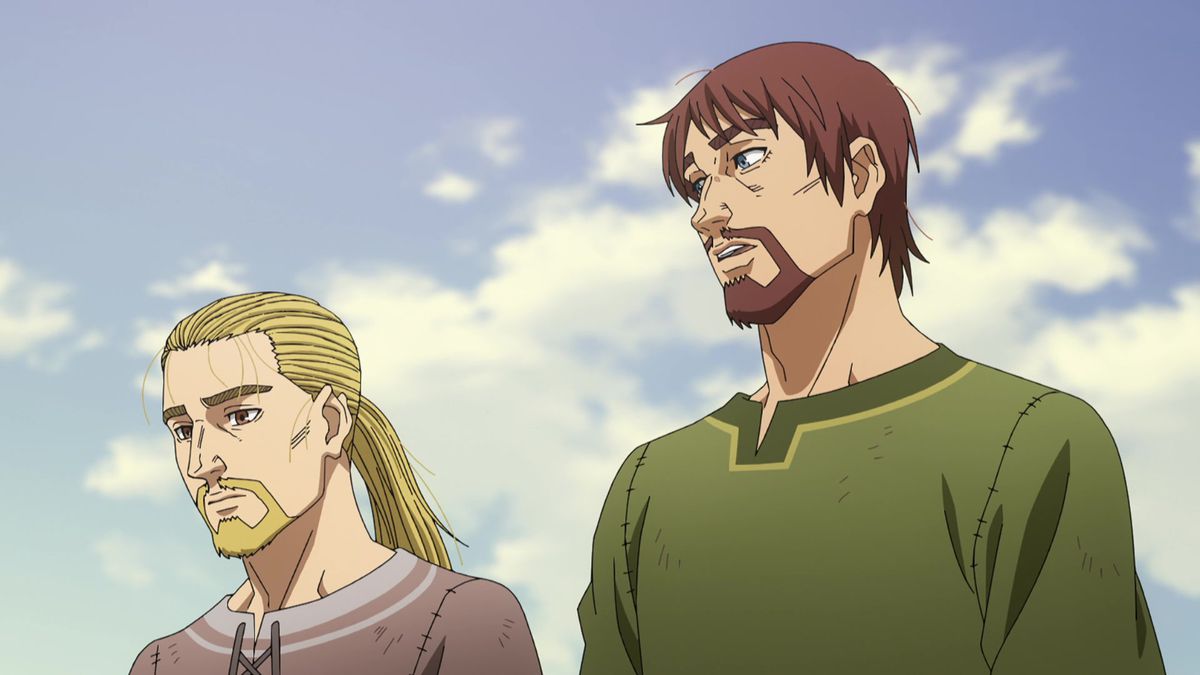
Multiple routes of escape from the ruinousness of Viking culture open up to Thorfinn as Einar draws him out of his shell. There’s Christianity, which gradually plays into Thorfinn’s route to pacifism, overhearing passages and recognizing his father Thors’ idea of a “true warrior,” someone who fights for peace rather than conquest of person or land. And then there’s Einar, who grew up on a farm that was raided multiple times by people like Thorfinn and the mercenaries he rode with. Einar stokes a rebellious and earnest spirit within him — headstrong, and perhaps naive, but synthesized with all those other voices it’s the beginning of an actual future for Thorfinn beyond simply surviving.
The cruelty of the culture that Thorfinn grew up in was always at the show’s forefront as its first season leaned into the ugliness of combat and conquest. Even when it found some thrills in the moment, there was a compelling contradiction in both marveling at the young fighter doing cool battle stuff even as it eroded his soul.
Most battle scenes in Vinland Saga are often arduous, with imagery and squishy sound design often in emphasis of the wound over of the action that caused it. Sweeping, painterly countryside vistas become extreme close-ups on injured characters drawn with rugged, realistic detail. It’s still fun to see headstrong brutes swagger around, but the banter always keeps an air of foreboding. The animation of the fights is flashy and often satisfying to watch, but the consequences are laid out punishingly on screen, both in the gory physical results and the emotional fallout — Thorfinn bearing plenty of both in the form of haunted dreams, gnarly scars, and some missing ear cartilage.
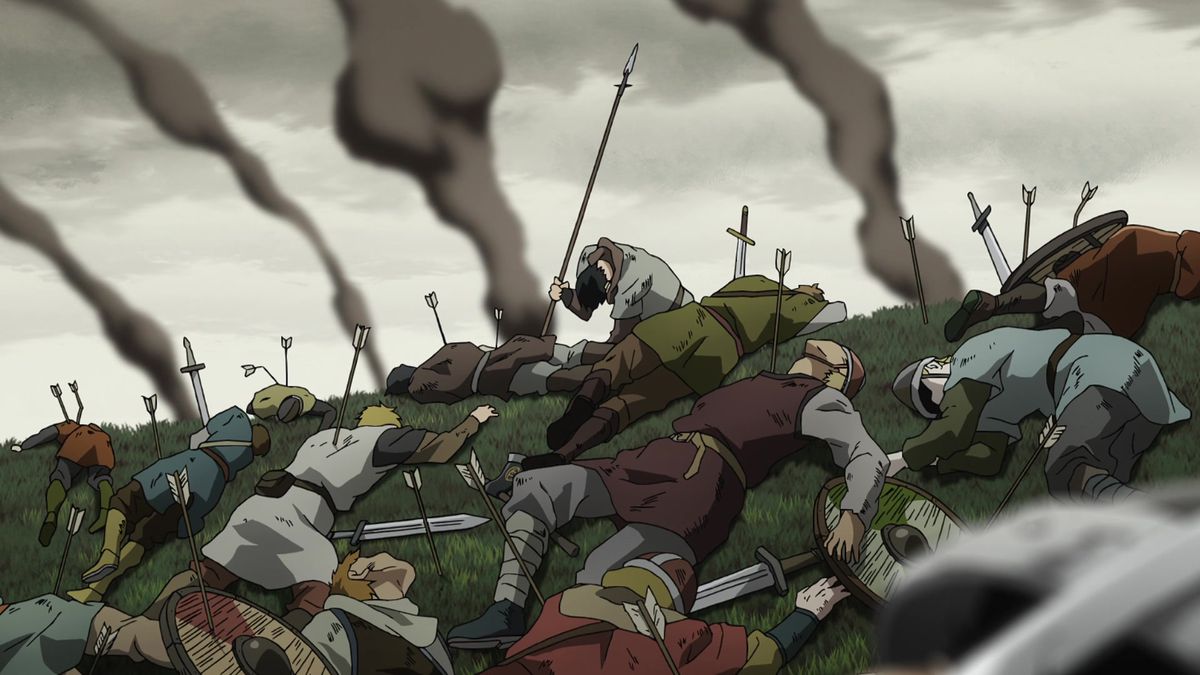
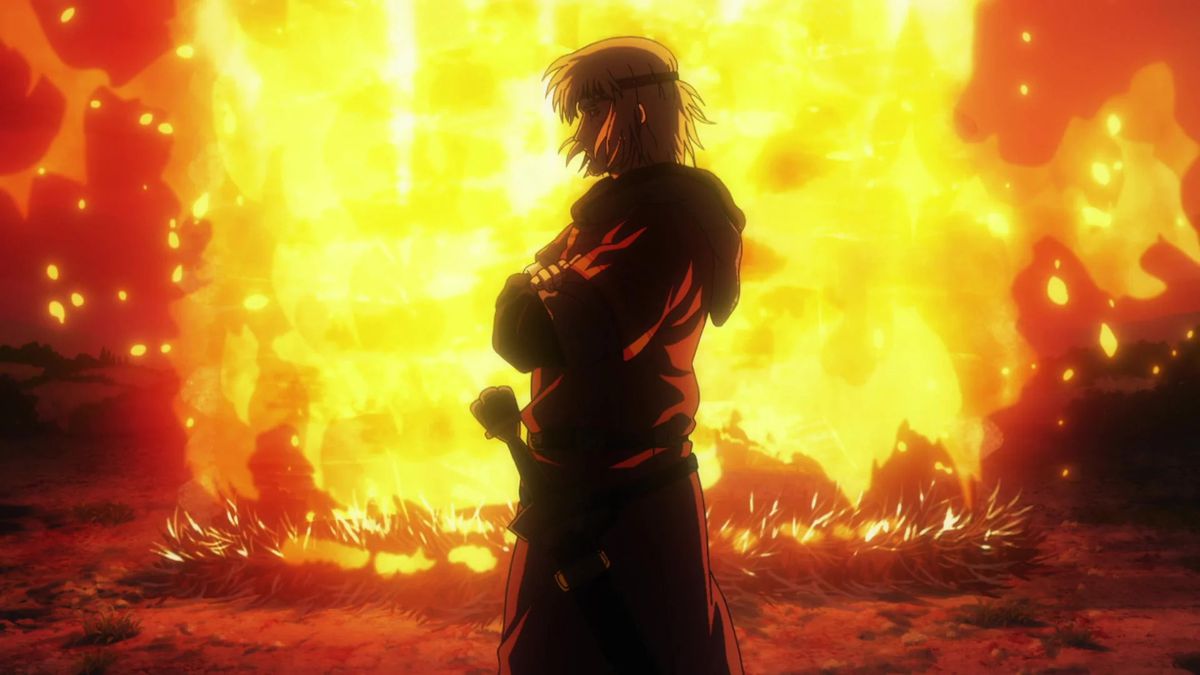
In the new season, with the character’s renewed perspective, such violence feels even more meaningless than it did before, especially seeing war treated as sport. It’s easier now to pay attention to the show’s more purely thrilling, bombastic action sequences, the ones it reserves for special cases. Thorfinn’s most purely heroic moment lies in him taking a beating just to find a route to conversation — his passive approach feeling practically revolutionary in a culture where people are measured by how much damage they can inflict. It’s also the clearest illustration of where Thorfinn is now compared to the first season, where committing harm to those who wronged him was his sole focus. The reason he succeeds, however, is also because he stops attempting to simply bury his past, instead embracing what he knows about fighting. To take less harm from the incoming punches, he rolls with the blows: He’s turning the other cheek, but strategically.
It’s one way in which his father’s idealism begins to merge with Askeladd’s and Einar’s pragmatism, and indicative of Thorfinn’s newfound agency. He now clearly knows his long-term goals and a semblance of what methods he could use; he’s a long way from the easily manipulated, violent young man of before.
Thorfinn is hardly the first anime pacifist born into warrior culture; plenty of soft-hearted shonen protagonists have wrestled with violence being the default answer to conflict and desperately sought alternatives (take the most popular example of feudal warfare solved by empathy and a good chat: Naruto and his “Talk-No-Jutsu”). Even the hollowness and existential ennui of a career defined by physical might is the subject of parodic series like One-Punch Man.
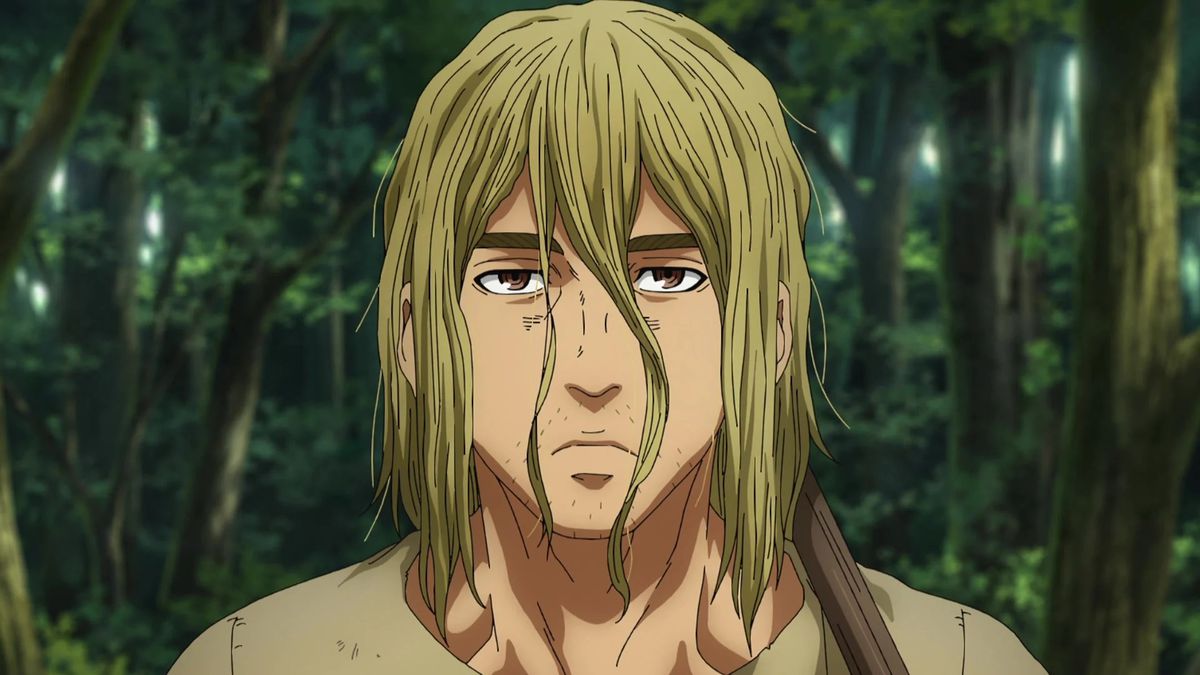
Perhaps what sets Vinland Saga apart is the unhurried length at which Yabuta and Seko agonize over Thorfinn’s questions about how to unlearn cultural violence; its second season is more patiently paced than the first in its exploration on how Thorfinn has inflicted violence on himself by committing violence in the world. The farm, for a time, feels like purgatory: isolated from the outside world, with the promise of salvation just out of reach and the ghosts of those that Thorfinn killed constantly threatening to drag him into his own personal hell.
Other characters are also trapped: Take Arnheid, another slave on the farm with Einar and Thorfinn, but with no discernable way out simply because she’s one of the owner’s favorites. Arnheid’s story illustrates one of the better qualities of Vinland Saga: a keen interest in the interior lives of people in Thorfinn’s orbit. There’s fascinating character study that the more patient structure allows to grow even more, as even the would-be villains of the piece feel human, which lends its warrior pacifist tale some more real-world bite.
To both escape his personal hell and to make amends, Thorfinn wants to build a peaceful nation “beyond the reach of slave traders and the flames of war,” in tribute to his father’s dream. Whether or not this is possible remains to be seen, but the season’s long journey to Thorfinn believing in something, getting his agency back, and making violence his last resort rather than his first, feels propulsive. “I don’t have any enemies” might not sound that profound coming from anyone else, but the road leading up to it is Vinland Saga’s most thrilling journey so far.
- SEO Powered Content & PR Distribution. Get Amplified Today.
- EVM Finance. Unified Interface for Decentralized Finance. Access Here.
- Quantum Media Group. IR/PR Amplified. Access Here.
- PlatoAiStream. Web3 Data Intelligence. Knowledge Amplified. Access Here.
- Source: https://www.polygon.com/23762422/vinland-saga-farmland-season-2-review
- :has
- :is
- :not
- :where
- $UP
- a
- About
- about farming
- Action
- actual
- actually
- adapts
- again
- against
- agency
- AIR
- All
- allows
- also
- alternatives
- always
- an
- and
- animation
- Anime
- Another
- answer
- any
- anyone
- apart
- approach
- Arc
- ARE
- around
- AS
- At
- attempting
- attention
- away
- back
- background
- Battle
- Battlefield
- BE
- because
- become
- been
- before
- Beginning
- being
- believing
- BEST
- Better
- Beyond
- Bit
- bodies
- born
- both
- boundaries
- breathtaking
- build
- Bunch
- but
- by
- CAN
- Career
- cases
- caused
- CBR
- change
- character
- characters
- Christianity
- Clearing
- clearly
- combat
- come
- coming
- commitment
- committing
- compared
- compelling
- conflict
- Consequences
- Consider
- constantly
- continuing
- Conversation
- Cool
- could
- Cross
- cultural
- Culture
- damage
- dead
- Default
- defined
- deliver
- Design
- desperately
- destroyed
- detail
- details
- DID
- different
- Director
- do
- doing
- Dont
- down
- Drama
- drawn
- draws
- dream
- dreams
- earn
- easier
- easily
- else
- embracing
- Empathy
- emphasis
- emphasizes
- engagement
- EPIC
- escape
- especially
- Ether (ETH)
- Even
- example
- existential
- expansive
- Experiences
- exploration
- extreme
- fallout
- fans
- far
- farm
- farming
- fascinating
- favor
- Favorites
- feel
- fighting
- fights
- Figure
- Figures
- Find
- First
- Focus
- For
- forefront
- forest
- form
- found
- Freedom
- Friendship
- from
- front
- fun
- future
- getting
- giant
- Goals
- good
- gradually
- Grow
- Growing
- Happening
- harm
- Have
- he
- him
- his
- historic
- historical
- How
- How To
- However
- HTTPS
- human
- idea
- illustrates
- in
- Incoming
- indicative
- inflict
- instead
- interest
- interior
- into
- isolated
- IT
- ITS
- journey
- jpg
- just
- Keen
- killers
- Land
- Last
- leading
- Length
- less
- letting
- License
- lies
- like
- little
- Lives
- Long
- long-term
- looking
- losing
- Lot
- make
- MAKES
- Making
- man
- manipulated
- measured
- Merge
- methods
- might
- missing
- moment
- Moments
- more
- most
- Most Popular
- motivations
- much
- multiple
- NARRATIVE
- nation
- Nature
- New
- no
- now
- of
- off
- often
- on
- ONE
- ones
- open
- or
- Orbit
- Other
- out
- outside
- over
- own
- owner
- paced
- paid
- part
- passive
- past
- patient
- patiently
- Pay
- peace
- People
- perhaps
- person
- personal
- perspective
- physical
- piece
- plato
- Plato Data Intelligence
- PlatoData
- plays
- Plenty
- Polygon
- Popular
- possible
- practically
- profound
- promise
- purely
- Puts
- qualities
- Questions
- raided
- rather
- reach
- real world
- realistic
- reason
- recognizing
- referred
- remains
- renewed
- reserves
- Resort
- Results
- revolutionary
- right
- road
- rolls
- Route
- routes
- saga
- same
- say
- Scale
- scenes
- scope
- Screen
- Season
- season 2
- Second
- see
- seeing
- seen
- sense
- Series
- Sets
- Shell
- shelters
- simply
- small
- smaller
- So
- so Far
- some
- Someone
- something
- Soul
- Sound
- Space
- special
- spirit
- Sport
- Still
- Stop
- Stops
- Story
- Strategically
- structure
- Study
- subject
- such
- Take
- takes
- taking
- tale
- talking
- tenets
- than
- that
- The
- the world
- their
- Them
- then
- There.
- they
- this
- those
- thrilling
- time
- times
- to
- top
- Traders
- treated
- Turning
- use
- Villains
- VOICES
- walking
- wants
- war
- was
- Watch
- Way..
- webp
- What
- when
- whether
- which
- WHO
- willing
- with
- within
- Work
- working
- world
- writer
- young
- zephyrnet


